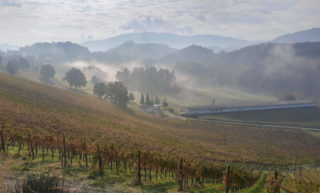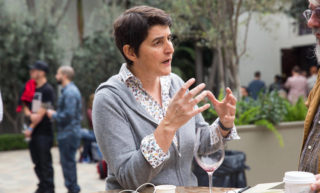Growth and Diversification
In the last two decades, England has established itself as a high-end producer of traditional method sparkling wine that many consider to be a serious alternative to Champagne. There is probably no other European country that has embraced English fizz with such enthusiasm as Norway. While the English winemaking industry is now coming of age, clouds seem to be gathering at the horizon, yet no challenge comes without a silver lining.
In his latest book, Oz Clarke describes how the English wine industry took off after an ambitious American couple founded Nyetimber. They were confident England had the perfect terroir to grow the traditional Champagne varieties. Despite scepticism and negative advice, they persevered and history has proven them right. Now, more than thirty years on and with average temperatures a fraction higher, Chardonnay and Pinot Noir are quicker to ripen and increasing experience continues to improve the quality of the wines. Combined with the large vintages of the last three years, the industry has attracted many new entrants while existing ones have expanded. The last ten years, the surface planted to vines increased by 150 percent and in 2019 alone 3.2 million vines were put in the chalky soils. It is a sure sign of success. However, the pace and magnitude carry a risk. In the next few years, large volumes of wine will flow onto the market. (It takes approximately three years before a newly planted vine starts to bear fruit.) As a result, many are now foreseeing downward pressure on the price. Ben Walgate, co-owner and winemaker at Tillingham, an organic outfit, paints the possible consequences: “The big estates and the niche players will probably be able to cope, but for the mid-sized firms things may get tough.”
Ben Walgate of Tillingham winery
Increasing the crop
With the cost of production high and the margins slim, how will wineries respond to the obvious challenge of lower prices? Ridgeview, with 120 hectares one of England’s larger wineries, is meeting it by striving for higher yields and economies of scale. Due to its fickle climate, yields in England are typically low and variable, which makes it more difficult to run a profitable business. Brandon Barnham, sales manager at Ridgeview, explains to me on the phone how they focus on maximising their crop. “We now carry out more in-depth site research before investing in new vineyards. We also pay more attention to canopy management in order to prevent diseases. And while good air circulation helps to avoid diseases, protection against strong winds that could damage the vines is another of our priorities to increase yields and thus profitability.”
Chardonnay in Ridgeview vineyard
Brexit pushes up costs
Brexit is also adding to the cost of a bottle wine. When exporting to the continent, duties and handling costs will inevitably increase the price of a bottle of wine for the final customer. Nonetheless, Wiston, a winery in West Sussex, is hopeful that once the Brexit dust has settled, export will continue as normal, at least for those wineries that already have established export markets. For new entrants it may be harder to build relationships. On the domestic market though, English fizz is now a more attractive option than imported wine of similar quality. But Dermot Sugrue, the winemaker at Wiston, emphasises it isn’t just the duties, taxes and handling costs for wines that add to the price, it is also the rising cost of getting supplies from Germany and France needed to make wine.
Reserve wines
It isn’t all gloom though. Triggered by the lavish vintages of the last few years, wineries (among them Ridgeview and Wiston) have been able to invest in reserve wines. Quite typical for young wineries, the need for cash flow forces them to sell all their wines as soon as possible. But being more firmly established, the recent large vintages give them the option to store some amounts of base wine to be used as blending options for future non-vintage sparklers.
Wiston House
New directions
Increased grape production will also lead to a more varied industry. Walgate, for example, expects more artisanal, organic, winemakers like himself. However, he is acutely aware of the fact that in the older, long-established wine regions, winemakers have more financial leeway. While many English wineries have been established with investments from well-paid Londoners who focus on a return on their investment, vineyards in old world countries have often been in the family for a long time, leaving new generations without the financial burden of a loan and allowing them to find new directions in farming, winemaking or both more easily.
Dermot Sugrue believes that organic farming will remain challenging with English weather conditions. Nonetheless, with dedication and resolve organic farming is possible in wetter climes too. Warmer and possibly drier summers will diminish disease pressure and hence the need to spray. On the flipside, if summers continue to warm up, the need to acidify may occassionally arise. It sounds like the unthinkable, but the topic was raised unprompted.
Diversification of production and styles
More variation in production method is expected too. While the vast majority of English sparklers now consist of high-end Champagne-style wines (with the second fermentation taking place in the bottle in which it is sold), we could also start seeing more Prosecco-style wines (second fermentation in a pressurised tank and no significant lees ageing) and even carbonated wines.
Additionally, other styles than Brut will appear on the market more often.
Under his own label Sugrue, for instance, has recently launched his first zero dosage: ZODO. “For obvious reasons, zero dosage wines are not very popular in England. The high acidity character of English wine asks for dosage.” However, as the summers grow warmer, sugar builds up more readily. But Sugrue proves that even in moderately warm summers excellent Brut Nature can be made. (See below for additional information on Sugrue’s 2014 ZODO.)
Moreover, for Wiston Sugrue has now also vinified a blanc de noirs, a style with a tad of tannic grip as well as aromas and flavours of red berries, while at Tillingham, Ben Walgate is making lovely pét-nats. (See below for additional information on Tillingham’s pét-nats.)
Barrels and amphoras
Experimentation with different types of vessels is another new development. “Right now the norm is to make English sparkling wine in stainless steel tank for maximum pure fruit expression”, says Sugrue. “But especially among smaller producers there are some who use barrels and even amphoras, but the large wineries simply need bigger tanks that are almost exclusively made of stainless steel.” Sugrue loves his experiments with wooden barrels. “Wiston is the only winery in England that currently has a traditional Coquard press like they use in the Champagne. So, why not use wooden barrels too?” Sugrue asks rhetorically. And continuing more seriously: “Barrel ageing softens the acidity, gives a richer texture and extra complexity.” Although a lean body and vibrant acidity may be trademarks of English sparkling wine, softening the acidity can be a beneficial thing, especially in cooler vintages. And using barrels is a gentler option than chaptalisation.
Dermot Sugrue
Developing a brand
Although there are wineries, like Ridgeview, Chapel Down and Nyetimber, that make a single-vineyard wine, mapping the unique terroirs remains a task for the future. “We simply do not yet know, which style works in which terroir. It will take us at least another two decades.” Walgate says. Nonetheless, Dermot Sugrue points out that English wine started off as being mostly from single vineyards. Estates were small, so wines were typically made with grapes from one vineyard. However, it disguises the fact that winemaking was quite exploratory. In a region like Burgundy, terroir definition is based on centuries of experience. “In general,” Sugrue says, “winemaking in England is currently focused on developing brands rather creating terroir-driven wines.”
Free-spirited
Likewise, devising an appellation system seems far off. Many, among them Sugrue, are not very keen on its inherent rules anyway. “One of the positive features of the English wine industry is that we are uninhibited by the choice of our grape varieties, farming methods, vinification practices, and so on.” For Sugrue that free-spirited attitude is worth keeping.
The English sparkling wine world is clearly going through a boom phase. If the first decades were about quality and establishing the product of English (sparkling) wine, now quantity and diversity will be the dominant vectors. As quantity may lead to a shakeout, diversity will help to alleviate this. Although English sparklers have an overall high average quality, going forward we may start to see more cost-effective production methods and other styles. For the consumer it means more choice and that is not a bad thing at all.
ZODO
ZODO is Sugrue South Down’s first zero dosage sparkling wine. As the 2014 harvest was exceptionally clean, Dermot Sugrue stored 1500 bottles meant to be released as his The Trouble with Dreams with extended lees ageing and full malolactic conversion of the sixty percent Chardonnay. (The other forty percent is Pinot Noir.) Over time it revealed different qualities and Sugrue decided not to add a sugar solution (or liqueur d’expedition) after disgorgement. ZODO is indeed bone dry, but without being austere. Due to several years of ageing in old wooden barrels, it has acquired a round mouthfeel. Typical brioche aromas and flavours are wrapped around a spine of high, but soft acidity. Ripe lemon, flinty minerality and a touch of oxidation add extra layers of flavour that linger on the palate pleasantly long. A new milestone in English winemaking!
COL’19
“You always have to keep an eye on your bank account,” says Ben Walgate stressing the “non-romantic” side of making wine. “At Tillingham we make a pét-nat, not only because we like the product, we also need the cash-flow.” Pét-nat finishes its first and only fermentation in bottle, trapping the carbon dioxide and rendering the wine fizzy and often cloudy. The wine doesn’t require much ageing and can be released quickly, normally in the spring after the harvest. Strictly speaking, Tillingham’s pét-nats are made col fondo (meaning: with what remains on the bottom) because they undergo a second fermentation in the bottle and are undisgorged. There is just a small amount of added sugar keeping the final amount of alcohol and the pressure in the bottle low. The COL’19, a blend of Pinot Noir, Auxerrois, Chardonnay and Meunier, is partly skin-fermented and partly vinified in qvevris. On the palate, the bone dry wine displays all shades of apples and apple peel, fresh cut grass, a hint of slightly bitter grapefruit, a waft of smokiness, light chalky minerality, a touch of earthiness and a bit of creaminess to round it off. It is a versatile wine, but with 9 percent alcohol, first and foremost a lovely summer aperitif.
A version (in Norwegian) of this article was published in Apéritif, spring 2021






Comments